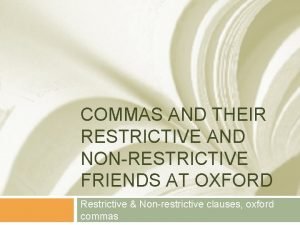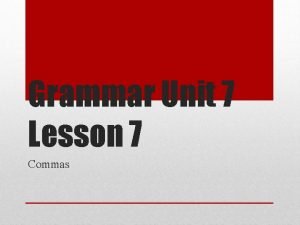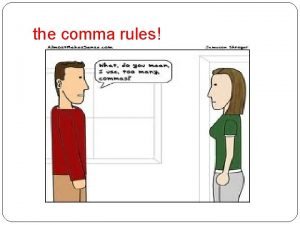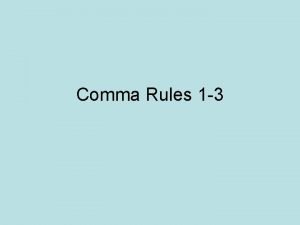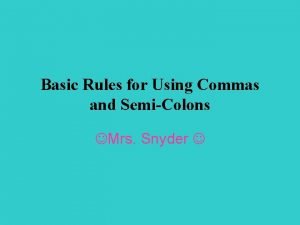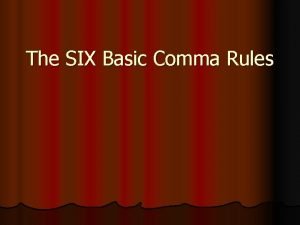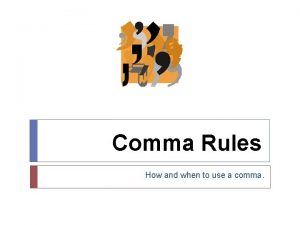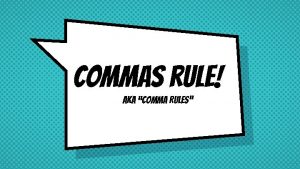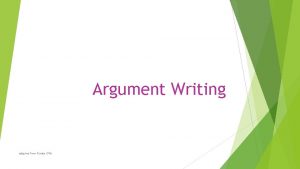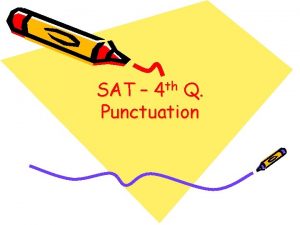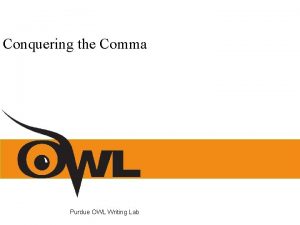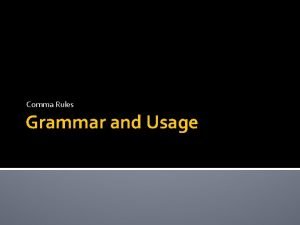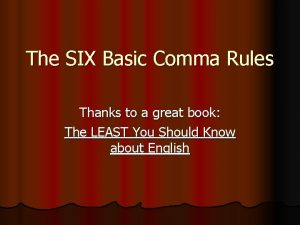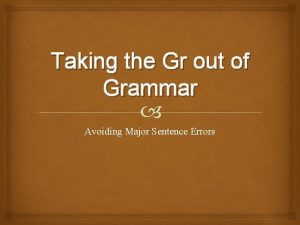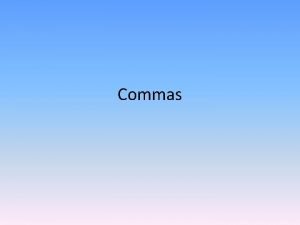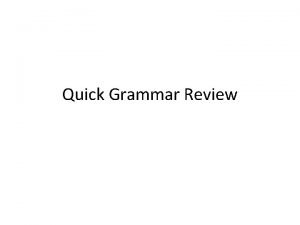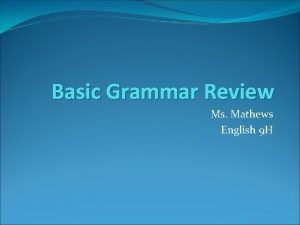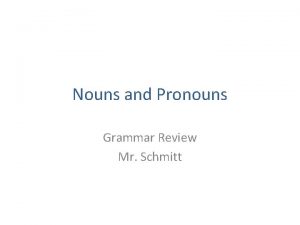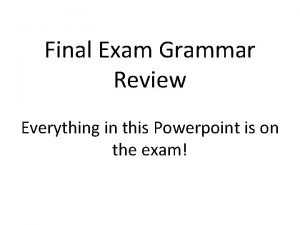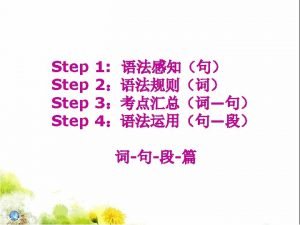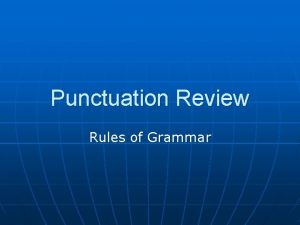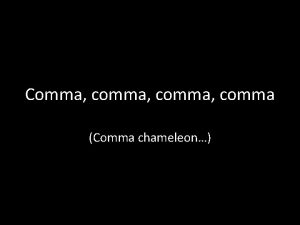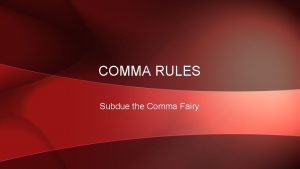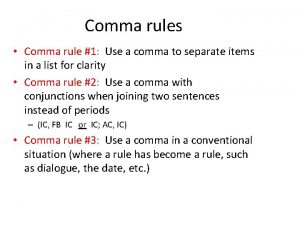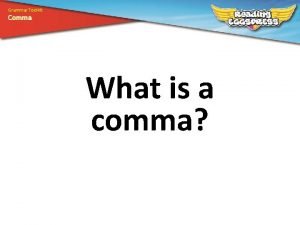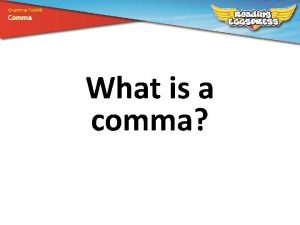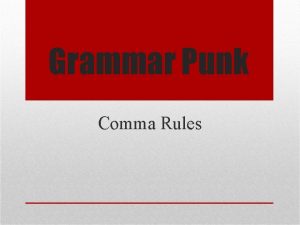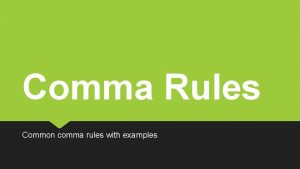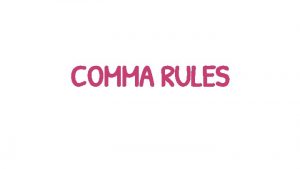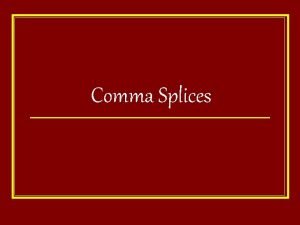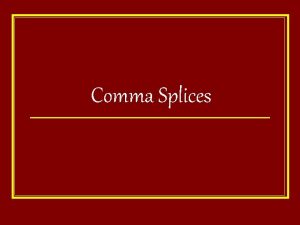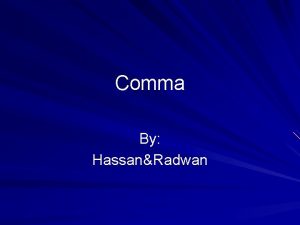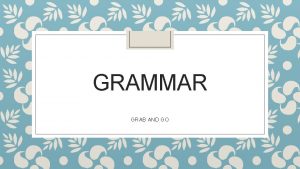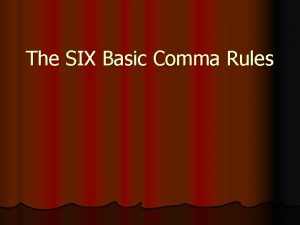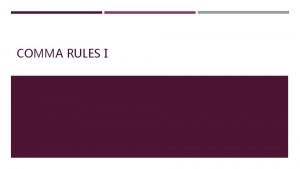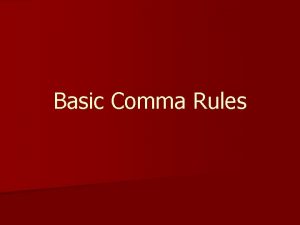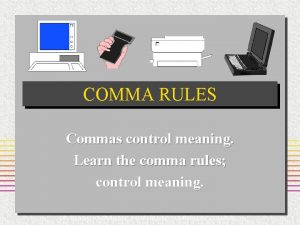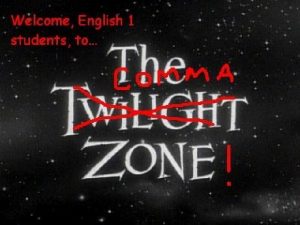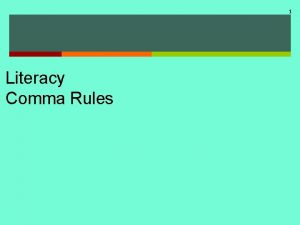the comma rules The Great Grammar Review Part



























- Slides: 27

the comma rules!

The Great Grammar Review, Part II Punctuation

the comma Most misused, and least understood, bit o’punctuation, we have a tendency to put commas, where we pause, in a sentence, to breath, to gather our thoughts, but rarely, according to how, our language is actually written. (commas intentionally misused!)

English test �On the ACT English test you must identify errors in �Expression – basic grammar and punctuation �Agreement* – antecedents, noun/verb, parallelism � Eloquence – fragments, run-ons, wordiness, etc. �Execution – author’s choices, placement, flow, etc.

the comma �Commas show up in: expression (punctuation is tested directly) agreement (commas are often distracters in lists and parallelism) eloquence (commas are used to fix run-ons and incomplete sentences) �Comma usage is tested more than any other punctuation because they are fundamental to organization of the language.

the comma rules! (in more ways than one) 1. A comma is used to make a list of three or more. 2. A comma is used to separate two adjectives. (the and rule) 3. A comma is used with a coordinating conjunction to combine two independent clauses. 4. A comma is used when a sentence begins with a dependent clause such as an interjection or introductory comment when the rest of the sentence can stand alone. If a sentence ends with a dependent clause following an independent clause do not use a comma. 5. A comma is used to separate contrasting parts of a sentence. 6. A comma is used to separate a parenthetical comment. This is called a comma off-set. 7. A comma is not used to separate a subject from its verb. The only exception is a comma off-set when two commas are used. 8. A comma is used to separate a statement from a tag question. 9. A comma is used to set off the name or title of a person

the comma rules!

the comma rules! 1. A comma is used to make a list of three or more. The recipe calls for half a loaf of cat, a tablespoon of gerbil spread, one cup of orange , slices and an onion. {the oxford comma: ACT likes it. } 2. A comma is used to separate two adjectives. and (the rule: if you can put and between the adjectives, it needs a comma. )

the comma rules! 3. A comma is used with a coordinating conjunction to combine two independent clauses. (this is perhaps the most tested comma rule) The cat is stupid. My wife still feeds it. We have two independent clauses. We need to use a comma and a coordinating conjunction (fanboys) to join them. The cat is stupid, but my wife still feeds it. We have two independent clauses, so we need to use a comma and a Fanboy.

the comma rules! 4. A comma is used when a sentence begins with a dependent clause (such as an interjection or introductory comment) when the rest of the sentence can stand alone. � Unfortunately, the rumor about the goat-in-theelevator incident is spreading. � Despite the popularity of Capra Aegagrus, few people will invite a goat to go to the movies with them. Do not use a comma if a sentence ends with a dependent clause following an independent clause. If a sentence ends with a dependent clause following an independent clause, do not use a comma. � The cat would not fit into the box despite folding his legs backward. � Despite folding his legs backward, the cat would not fit

the comma rules! 5. A comma is used to separate contrasting parts of a sentence. The bigger they are, the harder they fall. Cats should be served on toast, not pancakes. Note: this is an exception to rule #4 that says not to use a comma with a dependent clause at the end of a sentence.

the comma rules! � 6. A comma is used to separate a parenthetical comment. This is called a comma off-set. (A parenthetical comment provides additional information that is not essential to the sentence. ) The cat, who belongs to my neighbor, is stupid.

the comma rules!

the comma rules! � 7. A comma should not be used to separate a subject from its verb. The only exception is a comma off-set when two commas are used. The lizard, basking on a rock in the warm sun, was disturbed by a stupid cat. This is essentially the same rule as #6. The repetition is for emphasis.

the comma rules! � 8. A comma is used to separate a statement from a tag question. I hate it when my instructor uses tag questions, don’t you? Hand me that cat, would you?

the comma rules! � 9. A comma is used to set off the name or title of a person being addressed. It is shameful that you, The Cat, are always either asleep or demanding food. I think it’s time that you, T. C. , started paying rent.

the comma rules! � 10. A comma is used in dates, digits, and destinations. I died on April 22 th, 2011, and I’ll die again March 2013. I won 1, 000 gerbils in the lottery. The cat is happy. I have lived in La Grange, Kentucky, and Yellowknife, NWT, Canada, up above the arctic circle.

the comma rules!

Semicolons – there’s nothing semi about 'em! �Use a semicolon to join two related independent clauses. I’m tired of learning about punctuation; I wish it would end. �Use a semicolon to divide items on a list that has already used commas. I’ve been to La Grange, Kentucky; La Grange, Texas; and La Grange, New Mexico.

Colons are cool. �Colons have two uses: � 1. To start a list preceded by an independent clause. I need a few things from the store: a hammer, a biscuit, and two gold fish. � 2. To add a definition or explanation to the end of a complete sentence. There is only one reasonable thing to do: confess.

The comma rules!

Apostrophes �Are used to show possession ’s shows possession by one person. Bufordina’s feelings were hurt when Joe Bob's dog bit her. The team’s dog got sick after biting Bufordina. s’shows possession by more than one person. The students’ patience finally ran out. Cletus’dog ate the cat. (not Cletus’s)

Apostrophes �Possession of compound nouns It is my brother-in-law’s fault. My brothers-in-law are running away. My brothers-in-law’s birthdays all fall on Tuesday. �Are also used to create contractions they’re, can’t, I’d, it’s, who’s, etc.

Apostrophes �It --- basic pronoun. It ate the dog. �Its --- possessive form. Its got really big teeth. �It’s --- it is. It’s looking at you like it is hungry.

Dashes, Parentheses, and Stuff �These are used to enclose explanatory or qualifying remarks. The cat was an hour late (not that he’s very good at telling time) so we left him out of the party plans. The cat was an hour late - not that he’s very good at telling time - so we left him out of the party plans. Some folks don’t like avocados (it’s the texture not the taste). �The rule: if you open the gate you must close it! Or the cows will escape. Other stuff?

Perfect Punctuation! Your task is to do the following: Write an example for each comma rule and an example for colon and semi-colon use. Make the sentences thematic or write them as a story.

the comma rules!
 Comma comma comma chameleon meme
Comma comma comma chameleon meme What are commas for
What are commas for Chapter review motion part a vocabulary review answer key
Chapter review motion part a vocabulary review answer key Teeth possessive form
Teeth possessive form However commas
However commas Comma rule 4
Comma rule 4 Basic comma rules
Basic comma rules Comma rule 4
Comma rule 4 All comma rules
All comma rules Introduction purdue owl
Introduction purdue owl Sat comma rules
Sat comma rules Comma splices purdue owl
Comma splices purdue owl 10 comma rules
10 comma rules Six comma rules
Six comma rules Ic dc comma rules
Ic dc comma rules Lies comma rules
Lies comma rules Left linear grammar to right linear grammar
Left linear grammar to right linear grammar Traditional school of linguistics
Traditional school of linguistics Unrestricted grammar is also known as
Unrestricted grammar is also known as Right linear grammar
Right linear grammar Sat grammar review
Sat grammar review Quick grammar review
Quick grammar review H.grammar review
H.grammar review Personal noun
Personal noun Grammar review powerpoint
Grammar review powerpoint Kahoot
Kahoot Grammar review task 1
Grammar review task 1 When to use a comma before and
When to use a comma before and
